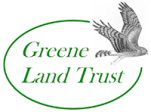
Grassland Stewardship
Throughout the northeastern US, grassland birds (birds that depend on grassland habitats) have been in rapid decline over the last several decades, with some species declining by 70-90%. This dramatic decline is due to changes in land use and loss of habitat that has resulted from development, the loss of small family farms, changes in farming practices, grassland fragmentation and reforestation.
The grassland birds most at risk in our area, and thus the focus of our conservation efforts, are the state-endangered Short-eared Owl and the state-threatened Northern Harrier. Greene County grasslands are home to several other migratory songbird grassland species that are also in decline and are of conservation interest. This “suite” of at-risk grassland-dependent birds contributes significantly to the biological diversity of our county and state and should be conserved. In order to halt the losses of these beautiful and significant birds, grasslands need to be protected and managed (mowed or grazed every few years) to prevent further losses and re-establish local grassland bird populations.
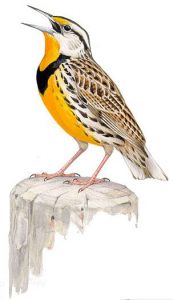
Unique Habitat Needs of Grassland Birds
Habitat includes all of the life cycle needs for a living thing to survive, including food, water, shelter or refuge, adequate habitat size, and in the case of grassland birds, areas appropriate and safe for courtship, nesting, breeding, rearing young, and roosting. Grassland birds are considered habitat “specialists” and have adapted over time to live only in environments dominated by grasses for most or all of their life cycle.
Why and how do grassland birds use grasses?
Grassland birds use their grassy habitat to find food, build their nests, and escape from predators. These birds eat a variety of foods found in the grasses ranging from grass seeds to crickets, grasshoppers and worms; and in the case of grassland raptors, such as the Northern Harrier and Short-eared Owl, small mammals such as meadow voles, small birds, and even small reptiles and amphibians. Grassland birds nest on the ground rather than in trees, using the structure provided by grasses both for the construction of the nest and as cover from predators. Ground nesting behavior leaves grassland birds vulnerable to disturbances such as mowing or haying during the breeding season. Nest predation and destruction, coupled with loss of habitat, are causing grassland bird populations to drop without a good chance of recovery. After leaving the nest, and later in the life cycle, grasses provide them with cover and protection from prey as they often do not fly from a predator, but run through the grasses to escape danger.
There are four major habitat requirements most important to sustaining grassland bird populations:
- Large expanses of connected grasslands creating a grassland landscape;
- Suitable grassland vegetation;
- Safe nesting areas in the summer; and,
- Suitable winter habitat for wintering grassland birds.
Greene County Birds
Click on the bird names below to link to Cornell’s Lab of Ornithology “All About Birds” pages for a description of each grassland bird, including audio recordings of its song.
Click on the bird names below to read fact sheets (PDFs) developed by Audubon New York about grassland birds.
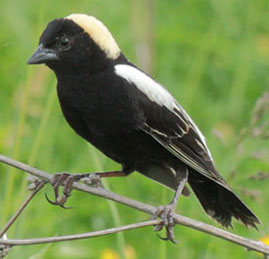
Habitat Requirement #1. Large expanses of connected grasslands creating a grassland landscape.
There are thousands of acres of grassland in eastern Greene County, which support the diversity of grassland birds that use the region. While some grassland birds, such as the Bobolink and Eastern Meadowlark can use grassland habitats as small as 10 acres, other species, including the Northern Harrier and the Short eared Owl require large, connected grassland areas, from 75 – 250 acres or more. Research shows that “area- sensitive” birds are not attracted to individual fields that are unconnected to other grassland habitats, but rather these birds are attracted to the entire grassland landscape that they can see. Therefore, to conserve these birds, we need to maintain larger expanses of connected grasslands throughout the landscape – even removing obstacles, like hedgerows, where possible. The general rule of thumb for a suitable grassland habitat patch size for most grassland birds, is the larger the better. Although grassland birds may use very small grasslands (under 40 acres, sometimes even under 10 acres) for foraging or other habitat needs, managing areas of at least 40 acres will provide most habitat needs for a diversity of grassland birds.
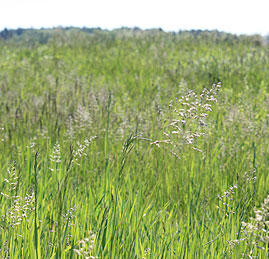
Habitat Requirement # 2. Suitable grassland vegetation.
A second key habitat factor for grassland birds is the presence of a large area dominated by grassy vegetation, with very few shrubs or trees (5% or less of total land cover is recommended), limited wildflowers or forbs (non-grass plants with broad leaves), and minimal presence of invasive plants (swallowwort, honeysuckle, buckthorn, multiflora rose, etc.). The ideal grassland habitat for most grassland birds will have a dominance of a variety of grasses with scattered forbs and an occasional tree or shrub. It is important to keep in mind that while the above describes an “ideal grassland”, many grassland birds will be attracted to a proximity to the ideal. In fact, many grassland birds can find useful habitat in a variety of grassland types, even actively farmed land, including hayfields, pasture and crop fields. Grasslands should have a diversity of grasses to support a variety of grass heights (from 10”-20”). Once established, a grassland suitable for grassland bird habitat will need to be mowed regularly (about every 2-3 years), or regularly grazed, and possibly periodically reseeded.
Click here for more information on grass species recommended for grassland bird conservation.
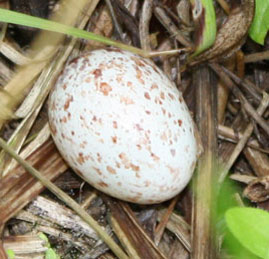
Habitat Requirement # 3. Safe nesting areas in the summer.
In school we learn that birds build their nests high up in trees to protect them from predators and people. Grassland birds, however, build their nests in the grasses, which makes them far more vulnerable. For example, the Eastern Meadowlark, after building several “starter” nests, will build her final creation on the ground or in a shallow depression, well-hidden in dense, grassy vegetation. Her nest will look like a cup with a dome-shaped roof interwoven with adjoining grasses and with a side entrance. For the Northern Harrier, nests are most successful in wet areas, such as in a wet meadow area or near a marsh within a grassland. Because they are on the ground, grassland birds’ nests, eggs and young are highly vulnerable to predators, destruction by mowers before the young fledge the nest, and lack of suitable nesting sites. In New York, grassland bird nesting season is from early May through late July. During these three months, the nests need to be protected from human disturbance in order for populations to survive and reproduce successfully. So, although mowing or grazing is required to keep grasslands in grassy vegetation, the timing of the mowing is critical for grassland bird survival and successful reproduction.
Grassland Bird Breeding and Mowing Timetable
| May | June | July | August |
|---|---|---|---|
| Begin identifying territories for nesting | Building nests and laying eggs. Eggs hatching. | “Fledging” of young birds – learning to fly and feed. | Most grassland birds have successfully fledged. |
| NOT safe to mow. | NOT safe to mow. | NOT safe to mow. | Mowing is safe*. |
*If mowing can be delayed until fall, this may be beneficial to certain grassland insects that are still completing their development (as larvae or pupae clinging to grasses) and may be harmed during summer mowing.
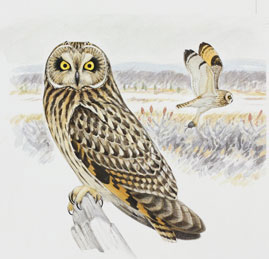
Habitat Requirement # 4. Suitable winter habitat for wintering grassland birds.
The two grassland bird species that are the primary targets of the Greene Land Trust’s grassland birds conservation efforts, the Northern Harrier and the Short-eared Owl, are both winter residents in the grasslands of Greene County (the harrier lives here year-round; the owl only lives here during the winter months). Their primary habitat needs over the winter are large expanses of grasslands (blocks of grasslands greater than 250 acres are essential for the owl), that are home to their main winter prey, the meadow vole. It is important that these large, open habitat areas contain a vegetative cover crop – such as rye, legumes or cornstalks – during the winter to provide habitat for these prey species. Sparsely located posts or trees around the perimeter of a grassland area can be important as resting places or observation posts from which to hunt. Finally, it is important to note that for birds, surviving the winter is hard work and so energy conservation is key. Every time a bird must spend energy by flying to catch prey, it depletes the energy it needs to stay warm. People who use grasslands in the winter can cause disturbance to wintering birds. Activities such as ATV or snowmobile use across fields, should be kept to a minimum in grassland bird habitat areas, even during the winter.
